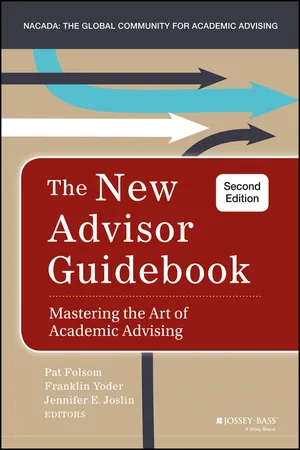
The New Advisor Guidebook
Mastering the Art of Academic Advising
- English
- ePUB (mobile friendly)
- Available on iOS & Android
The New Advisor Guidebook
Mastering the Art of Academic Advising
About this book
This is an exciting time to be an academic advisor—a time in which global recognition of the importance of advising is growing, research affirms the critical role advising plays in student success, and institutions of higher education increasingly view advising as integral to their missions and essential for improving the quality of students' educational experiences. It is essential that advisors provide knowledgeable, realistic counsel to the students in their charge. The New Advisor Guidebook helps advisors meet this challenge.
The first and final chapters of the book identify the knowledge and skills advisors must master. These chapters present frameworks for setting and benchmarking self-development goals and for creating self-development plans. Each of the chapters in between focuses on foundational content: the basic terms, concepts, information, and skills advisors must learn in their first year and upon which they will build over the lengths of their careers. These chapters include strategies, questions, guidelines, examples, and case studies that give advisors the tools to apply this content in their work with students, from demonstrations of how student development theories might play out in advising sessions to questions advisors can ask to become aware of their biases and avoid making assumptions about students to a checklist for improving listening, interviewing, and referral skills. The book covers various ways in which advising is delivered: one-to-one, in groups, and online.
The New Advisor Guidebook serves as an introduction to what advisors must know to do their jobs effectively. It pairs with Academic Advising Approaches: Strategies That Teach Students to Make the Most of College, also from NACADA, which presents the delivery strategies successful advisors can use to help students make the most of their college experience.
Frequently asked questions
- Essential is ideal for learners and professionals who enjoy exploring a wide range of subjects. Access the Essential Library with 800,000+ trusted titles and best-sellers across business, personal growth, and the humanities. Includes unlimited reading time and Standard Read Aloud voice.
- Complete: Perfect for advanced learners and researchers needing full, unrestricted access. Unlock 1.4M+ books across hundreds of subjects, including academic and specialized titles. The Complete Plan also includes advanced features like Premium Read Aloud and Research Assistant.
Please note we cannot support devices running on iOS 13 and Android 7 or earlier. Learn more about using the app.
Information
Part One
Mastering the Art of Advising
1
Mastering the Art of Advising: Getting Started
Watching a skilled [advisor] help a student is like watching an artist at work. Each makes their craft look easy. The artist applies paint to canvas with a seemingly effortless ease, and the work of art magically appears. [Master] advisors . . . conduct conferences with an equal ease and fluidity.—Pat Folsom (2007, p. 13)
Of course, the ease or effortlessness with which advisors and artists practice their craft creates a false impression; both advisor and artist are seamlessly integrating [and thoughtfully applying] multiple components of their respective crafts that took years to learn. For advisors in training or new advisors, observing an experienced advisor can be simultaneously inspiring and overwhelming. New advisors see the advisors that they want to become and recognize that they have a long way to go to master the craft. (Folsom, 2007, p. 13)
Mastering the Art of Advising
The Art of Advising
Table of contents
- Cover
- Title page
- Copyright
- Series
- Dedication
- Preface
- Acknowledgments
- The Editors
- The Authors
- PART ONE Mastering the Art of Advising
- PART TWO Foundations: The Conceptual Component
- PART THREE Foundations: The Informational Component
- PART FOUR Foundations: The Relational Component
- PART FIVE Delivering Advising
- PART SIX Advisor Development for Foundational Mastery
- APPENDIXES
- Index
- EULA